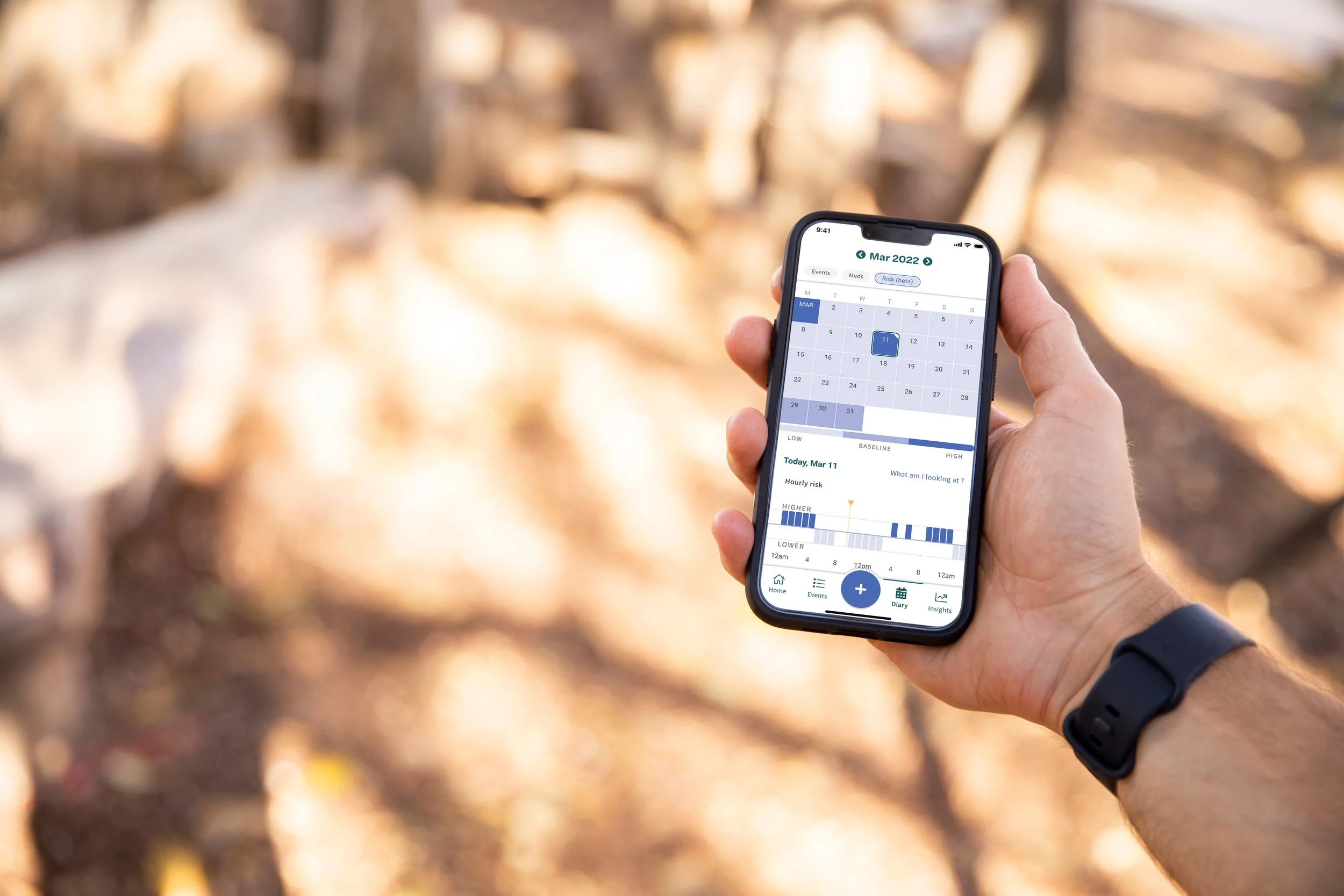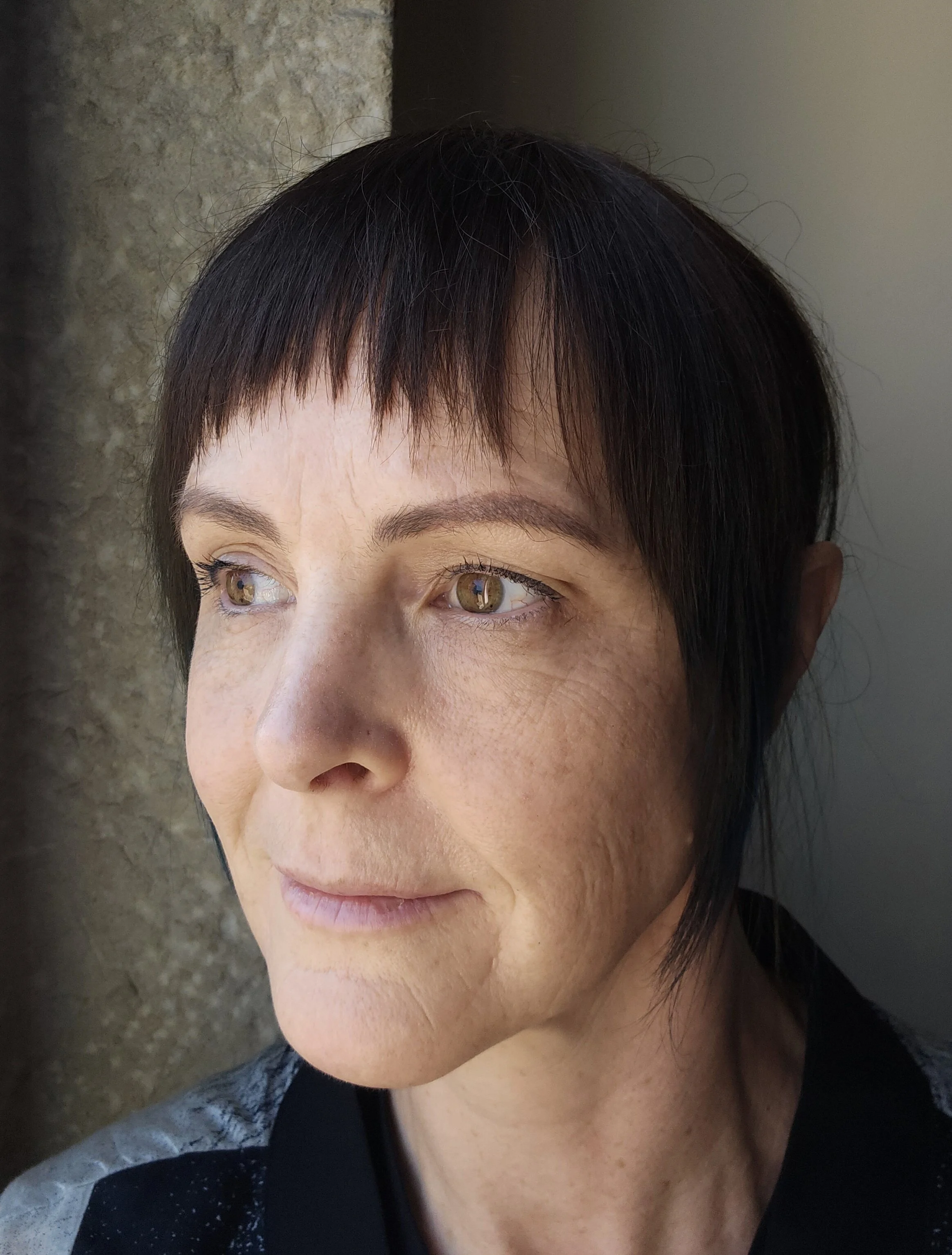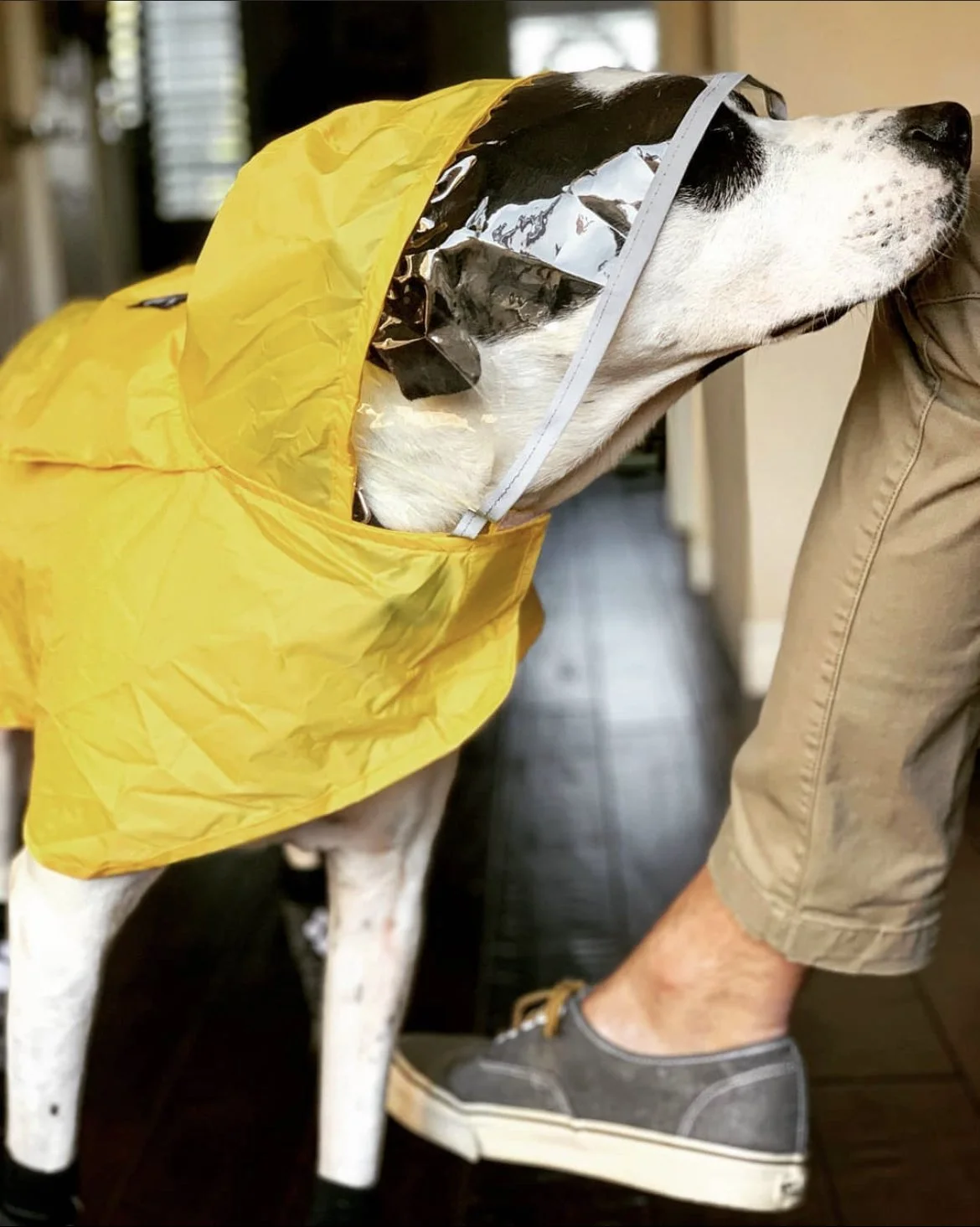Creating a Forecast for Seizures
Researchers develop a tool to help people with epilepsy plan ahead
The Seer App from Seer Medical. The app gives individual users 24-hour and long-term seizure risk predictions. Image credit: Seer Medical
by Alison Jarman
June 21, 2023
Fiona Waugh’s seizures often start with the F-word. She tells me this early in the interview, so, when it comes, I’m not surprised. I watch her on Zoom as she stammers a few words, then her voice fades away. The left side of her face twitches, and she rocks back and forth, her lips forming lopsided shapes, until she gives me a thumbs up about 90 seconds later.
“It’s kind of like my body’s working, but my brain has gone to sleep for a little bit,” says Waugh about her seizure symptoms. “I might cry as part of it, and I'm not sad. It's just what my brain is doing.”
Waugh’s epilepsy mostly triggers focal impaired awareness seizures. Unlike tonic-clonic seizures, which affect the entire body and can cause collapse and convulsions, Waugh’s seizures cause facial and arm movements and a loss of consciousness. Afterward, she knows she’s had a seizure, but she doesn’t remember what happened during it. Importantly, she doesn’t experience any warning signs or aura before the seizure.
***
People with epilepsy have reported that one of the most disabling features of the condition is not knowing when a seizure will happen. Without good seizure control, people with epilepsy can’t safely drive, swim alone, or work in jobs that might be dangerous if they were to lose consciousness. According to the World Health Organization, around 50 million people worldwide are living with epilepsy. Studies have shown that up to one-half of patients have not achieved seizure control, despite the development of newer anti-seizure medications.
Scientists are now combining years of seizure pattern observations with newer technologies to develop a way to predict seizure risk, like giving a weather forecast for the brain.
This EEG, from a single participant in Cook's 2013 study, shows the cyclical pattern of seizure activity. Each red dot represents a seizure. Image credit: Pip Karoly
Seizures have long been thought to come in cycles. For hundreds of years, doctors have documented daily patterns or longer rhythms over days or weeks; they have blamed the moon or perhaps menstruation for these repetitions. Philippa (Pip) Karoly, a data scientist and biomedical research engineer at the University of Melbourne in Australia, has merged these ancient observations with newer sources of data — electroencephalogram, or EEG recordings from brain implants, online seizure diaries, and wearable devices — to better understand seizure cycles.
When average brain activity is plotted over a long period of time, patterns emerge. “It’s really visual,” she said of the graphs showing the highs and lows of each participant’s EEG signals. “You can just see it beautifully . . . this rise, peak, and trough. Just a very, very clear cycle.”
Karoly’s research, published in The Lancet Neurology in 2018, showed that seizures cluster at a certain time of day, or in a multiday cycle, and that this pattern is different for everyone.
***
Waugh is aware that her seizures come in clusters every two to five weeks. During these clusters, she knows it is going to be a bad day when she has three seizures before she leaves the house. But knowing a more detailed pattern would make a huge difference in her working life in the nonprofit sector.
“It'd be fabulous, because I love the kind of work that I do. It means talking to people I don't know,” says Waugh about the possibility of a seizure forecast. “So to know in advance would mean that I can accurately say to someone … [it’s] highly likely I'm going to have a seizure whilst I'm talking to you.”
***
An illustration of a surgically implanted electrode, as used in the 2013 study. Image credit: Pip Karoly
Karoly’s 2018 findings drew from data collected as part of an earlier research effort led by University of Melbourne epilepsy researcher Dr. Mark J. Cook to develop a prototype seizure warning system for patients. That study, published in The Lancet Neurology in 2013, collected EEG recordings from 15 participants with surgically implanted electrodes over periods of up to two years. The electrodes were connected to wires that ran under the skin to a small device in the upper chest, like a cardiac pacemaker. This device recorded EEG data and transmitted signals to a small box, like a pager, that participants carried with them. As the study gathered more information about each individual, their individual risk profiles were analyzed, and an alert was transmitted when they were in a high-risk seizure period. The light on the pager would then switch from blue to red.
To build this warning system, researchers first needed to train a computer to recognize a seizure. This involved machine learning: a computer program was fed repeated examples of data that represented “seizure” or “not seizure” from EEG recordings. With enough exposure, the program processed new data and sorted it without being told the answer.
In general, there has been broad agreement among epilepsy researchers about what represents a seizure. However, defining the period before a seizure, or the pre-ictal state, has proven more difficult. For these researchers, this has made it challenging to provide a warning system that could actually give people enough time to get to safety or to warn someone else before they have a seizure.
“Wearables may help augment diaries by capturing seizures that people aren’t aware of. Many people have multiple seizure types, and in diaries, they often report some but not others.”
By contrast, Karoly and her colleagues have focused on developing a risk forecasting model, rather than a device that warns about specific events. To return to the weather analogy, they have designed an app that gives both 24-hour and long-term seizure risk forecasts. Using machine learning, the engineers built upon the data from the 2013 study, as well as information from online diaries.
Online seizure diaries have played a key role in the development of seizure forecasting technology. The My Seizure Gauge initiative, a research program of the U.S.-based Epilepsy Foundation, made an enormous amount of information recorded by people about their seizures available to epilepsy researchers. To build a seizure risk forecasting system, Karoly, who was awarded the prestigious Prime Minister’s Prize for New Innovators in 2022, partnered with other researchers to form biotech company Seer Medical, focused specifically on epilepsy and neural engineering research. But to sharpen the data signals that diaries could provide, they have added other sources of individualized data from devices that are far less invasive than electrodes in the brain.
***
In a converted warehouse on the edge of Melbourne’s central business district, Ewan Nurse, a research engineer at Seer Medical, leads me to the table of wearable gadgets. A disembodied head sits covered in leech-like electrodes. Next to it are a couple of devices that look, respectively, like a chunky Fitbit and a sleek, futuristic wedding ring.
There are a pair of small, black square tiles sitting beside the ring. According to Nurse, these are the least popular of the wearables. Around an inch across, they each contain a single electrode for detecting brain activity and are hard to hide beneath a receding hairline. They also don’t look like any other kind of accessory. The challenge, as Nurse explains, is to balance the needs of the research with what people will wear — something that “doesn’t scream out, ‘Hey, I’m wearing a medical device.’”
A wearable device made by Seer Medical. This device records physiological information such as heart rate and body movement, along with the EEG signals that indicate seizure activity. Image credit: Seer Medical
A close up image of an electrode from a wearable seizure recording device. Image credit: Seer Medical
These wearable devices record physiological information such as heart rate and body movement, along with the EEG signals that indicate seizure activity. There is no need for surgery to use them, which means lower risk for the user, but also lower signal quality. However, this doesn’t mean the data isn’t useful.
***
“All information is good information. Even if it’s noisy data, you can combine it with multimodal data, and [together] they are stronger than the sum of their parts,” said Karoly.
Wearables may also help identify pre-ictal states. Recent research has shown that there are characteristic heart rate, movement, and skin temperature changes that could help predict the period before a seizure almost as well as EEG signals. Nurse cautioned that this often applies only to seizures that involve more movement, such as generalized tonic-clonic seizures.
“For adults, that's really not the majority of seizures. But the other side of that coin is they are the most dangerous,” he said. People who suffer from tonic-clonic seizures are at higher risk of injury and even death. It is too soon to say whether the Seer technology will help to reduce these kinds of risks, but since the launch of the Seer app in 2022, Nurse said over 2,000 forecasts have been generated.
For Nurse, this is exciting. “There's been decades of academics sitting around looking at each other and talking about seizure forecasting. And it's great to have [it] actually out there,” he said.
People who use the Seer app along with wearables contribute to their own risk forecast, as their data is fed back into their personal forecasting algorithm. In addition to forecasting, the app can help users manage their medications, notify someone at the time of a seizure, and record seizures in a diary after they happen. This is important, as many people suffer from temporary amnesia afterward. “Often, patients don’t know they have had a seizure until they walk into the kitchen and see the broken glass on the floor,” said Nurse.
Wearables may help augment diaries by capturing seizures that people aren’t aware of. Many people have multiple seizure types, and in diaries, they often report some but not others. It is crucial to record the number of seizures a person has, as it can guide both research and treatment decisions of neurologists and their patients. “Even if we can use that multimodal data to get a better seizure count for people, that would just be a huge win,” said Nurse.
Dr. Patrick Kwan, co-director of the Monash Institute of Medical Engineering in Melbourne, Australia and former head of epilepsy at Alfred Health, sees the combination of wearables and online diaries as something that could make seizure counts for research more efficient. There are existing research tools to correct for underreporting, but they tend to affect the whole sample.
Kwan said that using the right language for seizure forecasting is also important. Weather is a useful analogy, but it has its limitations. The concept of forecasting the likelihood of a seizure is hard for many to understand. The idea of a weather forecast also carries certain connotations.
“It gives us a sense that the weather is out of our control,” said Kwan. “Whereas with seizures, if there was a way to forecast, there are ways we can avoid having seizures. You can interfere.”
Interfering might mean taking steps to reduce the likelihood of seizures, such as protecting oneself from injuries, getting plenty of sleep, avoiding alcohol, and working with a neurologist to find the right medication.
Karoly acknowledged that the usefulness of a tool like the Seer app is different for everyone. Some people like the long-term forecast so they can plan social activities, and “some people would only want it if it is giving them that imminent ‘one's coming’ kind of warning,” she said. Research on how people are using the app will help guide Karoly and her team in targeting what people find helpful. “I would like to get to a point where we can tell people they are safe to drive,” she said.
***
Waugh, who was diagnosed with epilepsy in her thirties, really misses the independence of driving. But she feels the burden that her epilepsy places on others even more intensely, becoming teary as she talks to me. She would love to be able to reassure her partner Neil that it’s safe for him to go out without her.
“He avoids going out when I'm having a lot of seizures, so he's missing out on things. It has an impact on his life,” says Waugh.
Waugh would also like to be able to soften the reaction from strangers, who are often fearful of her during seizures. She doesn’t blame them for this and, when she can, uses it as an opportunity to educate.
“I just say, ‘Oh yes, I've got epilepsy. I just had a seizure.’ It actually stimulates conversation and, yeah, I love it when it's like that,” says Waugh.
Alison Jarman
Alison Jarman is an anesthesiologist and writer based in Melbourne, Australia. She advocates for global access to safe surgery and health care improvement through education, taking these interests to northern and central Australia, Mongolia, and Zambia. She is a graduate student in the Johns Hopkins University Science Writing Program. She believes good writing can transform health practice and has previously published in Muse magazine on hypnosis for children with needle phobia.
Senior Editor: Armi Rowe
Art Editor: Tara Holley
Copy Editor: Christopher Graber











